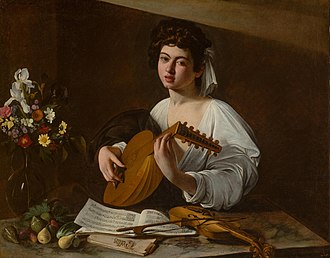
| Part of a series on |
| Renaissance music |
|---|
| Overview |
|
|
|
|
A madrigal is a form of secular vocal music most typical of the Renaissance (15th–16th centuries) and early Baroque (1600–1750)[citation needed] periods, although revisited by some later European composers.[1] The polyphonic madrigal is unaccompanied, and the number of voices varies from two to eight, but the form usually features three to six voices, whilst the metre of the madrigal varies between two or three tercets, followed by one or two couplets.[2] Unlike verse-repeating strophic forms sung to the same music,[3] most madrigals are through-composed, featuring different music for each stanza of lyrics, whereby the composer expresses the emotions contained in each line and in single words of the poem being sung.[4]
Madrigals written by Italianized Franco–Flemish composers in the 1520s partly originated from the three-to-four voice frottola (1470–1530); partly from composers' renewed interest in poetry written in vernacular Italian; partly from the stylistic influence of the French chanson; and from the polyphony of the motet (13th–16th centuries). The technical contrast between the musical forms is in the frottola consisting of music set to stanzas of text, whilst the madrigal is through-composed, a work with different music for different stanzas.[5] As a composition, the madrigal of the Renaissance is unlike the two-to-three voice Italian Trecento madrigal (1300–1370) of the 14th century, having in common only the name madrigal,[6] which derives from the Latin matricalis (maternal) denoting musical work in service to the mother church[2][need quotation to verify] or from the post-classical Latin matricalis (maternal, simple, primitive).[7]
Artistically, the madrigal was the most important form of secular music in Renaissance Italy, and reached its formal and historical zenith in the later-16th century, when the form also was taken up by German and English composers, such as John Wilbye (1574–1638), Thomas Weelkes (1576–1623), and Thomas Morley (1557–1602) of the English Madrigal School (1588–1627). Although of British temper, most English madrigals were a cappella compositions for three to six voices, which either copied or translated the musical styles of the original madrigals from Italy.[2] By the mid-16th century, Italian composers began merging the madrigal into the composition of the cantata and the dialogue; and by the early 17th century, the aria replaced the madrigal in opera.[6]
- ^ Hobson, James (2015). Musical antiquarianism and the madrigal revival in England, 1726-1851 (Ph.D.). University of Bristol. Retrieved 2 October 2022 – via EThOS.
- ^ a b c J. A. Cuddon, ed. (1991). The Penguin Dictionary of Literary Terms and Literary Theory. p. 521.
- ^ Tilmouth, Michael (1980), "Strophic", in Sadie, Stanley (ed.), The New Grove Dictionary of Music and Musicians, vol. 18, London: Macmillan Press, pp. 292–293, ISBN 0-333-23111-2
- ^ Scholes, Percy A. (1970). Ward, John Owen (ed.). The Oxford Companion to Music (Tenth ed.). Oxford: Oxford University Press. p. 308. ISBN 0-19-311306-6.
Durchkomponiert (G.) Through-composed; applied to songs with different music for every stanza, i.e. not merely a repeated tune.
- ^ Brown 1976, p. 198
- ^ a b von Fischer & et al. 2001
- ^ "madrigal". Oxford English Dictionary (Online ed.). Oxford University Press. (Subscription or participating institution membership required.)